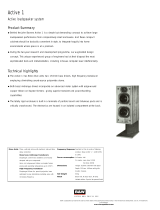JBL TL260 offers an optimal soundstage with its 4 transducers covering ultrahigh, high, midrange, and mid-bass frequencies, as well as a 12” low-frequency transducer for an immersive listening experience. With a maximum recommended amplifier power of 250W and a continuous/peak power handling of 125W/500W, this speaker is suitable for various audio setups. Its sensitivity of 92dB ensures efficient sound reproduction, while the frequency response of 32Hz – 40kHz (-3dB) provides a wide range of audible frequencies.
JBL TL260 offers an optimal soundstage with its 4 transducers covering ultrahigh, high, midrange, and mid-bass frequencies, as well as a 12” low-frequency transducer for an immersive listening experience. With a maximum recommended amplifier power of 250W and a continuous/peak power handling of 125W/500W, this speaker is suitable for various audio setups. Its sensitivity of 92dB ensures efficient sound reproduction, while the frequency response of 32Hz – 40kHz (-3dB) provides a wide range of audible frequencies.




-
 1
1
-
 2
2
-
 3
3
-
 4
4
JBL TL260 offers an optimal soundstage with its 4 transducers covering ultrahigh, high, midrange, and mid-bass frequencies, as well as a 12” low-frequency transducer for an immersive listening experience. With a maximum recommended amplifier power of 250W and a continuous/peak power handling of 125W/500W, this speaker is suitable for various audio setups. Its sensitivity of 92dB ensures efficient sound reproduction, while the frequency response of 32Hz – 40kHz (-3dB) provides a wide range of audible frequencies.
Ask a question and I''ll find the answer in the document
Finding information in a document is now easier with AI
Related papers
Other documents
-
Infinity Reference RS-8 Owner's manual
-
Infinity ALPHA Simple Setup Manual
-
Harman GT-X424 User manual
-
 Bowers & Wilkins Active1 User manual
Bowers & Wilkins Active1 User manual
-
Harman/Kardon CA-470E User manual
-
Infinity ALPHA10B User manual
-
Tannoy Precision User manual
-
Harman Kardon Speaker 100.3SE User manual
-
Harman Kardon GLA-55 Owner's manual
-
Terex TL260 Operating Instructions Manual




